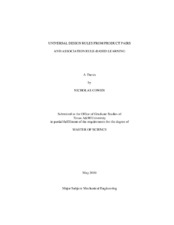| dc.description.abstract | A product pair is two products with similar functionality that satisfy the same
high level need but are different by design. The goal of this research is to apply
association rule-based learning to product pairs and develop universal design rules to be
used during the conceptual design phase. The Apriori algorithm produced 1,023
association rules with input parameters of 70% minimum confidence and 0.5%
minimum support levels. These rules were down-selected based on the prescribed rule
format of: (Function, Typical User Activity) ? (Change, Universal User Activity). In
other words, for a given product function and user activity, the rules suggest a design
change and new user activity for a more universal product.
This research presents 29 universal design rules to be used during the conceptual
design stage. These universal design rules suggest a parametric, morphological,
functional, or no design change is needed for a given user activity and product function.
No design change rules confirm our intuition and also prevent inefficient design efforts.
A parametric design change is suggested for actionfunction elements involving find hand
use to manipulate a product. Morphological design changes are proposed to solve actionfunction elements in a slightly more complex manner without adding or
subtracting overall functionality. For example, converting human energy to mechanical
energy with the upper body opposed to the lower body or actuating fluid flow with
motion sensors instead of manual knobs. The majority of the recommended functional
changes involve automating a product to make it more universal which might not be
apparently obvious to designers during conceptual design. | en |


